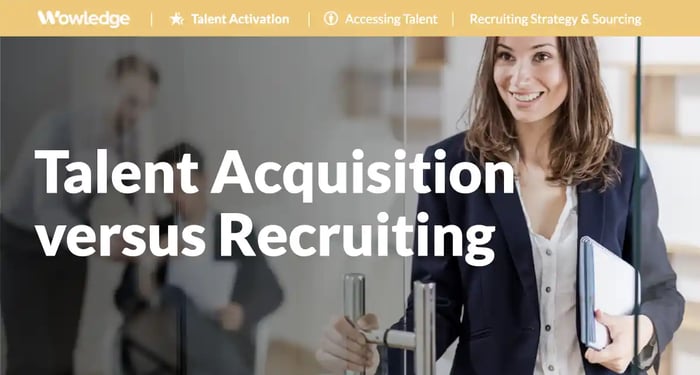Responding to challenging labor markets and significant shifts in employee and candidate behavior requires a recognition of the critical importance of building a comprehensive strategy and capability to acquire and retain top talent. The use of "talent acquisition" versus "recruiting" terms is often viewed as interchangeable, but a nuanced understanding of their distinctions is crucial in addressing the difficulties companies face today. Talent acquisition versus recruiting extends beyond the traditional hiring process, encompassing a strategic, long-term approach to planning, identifying, attracting, and nurturing top talent. Organizations often navigate various challenges in the quest for sustained success, from a rapidly changing job market to evolving candidate expectations. Leveraging integration with workforce planning, talent strategy, and talent management becomes essential in establishing a robust foundation for a comprehensive talent acquisition strategy. This integration ensures alignment with organizational goals and promotes a proactive approach to overall staffing management. In this context, there are key steps to build an effective talent acquisition strategy, including the essential elements that organizations must consider to stay ahead in the talent game.
Comparing and contrasting talent acquisition with recruiting
Talent acquisition (TA) is a comprehensive and long-term approach to identifying and fulfilling future staffing requirements, focusing on targeted talent attraction and relationship management, skills acquisition, and cultural fit. Recruiting refers to the process of responding to immediate and short-term needs by sourcing, screening, selecting, and hiring staff to fill well-defined roles. While recruiting is critical, it represents a more mechanical part of a larger, more strategically aligned talent acquisition capability. In fact, the difference between “recruiters” and “TA specialists” lies in the focus on a repeatable process by recruiters (source, screen, select, hire) versus TA specialists (research markets, identify pools of potential candidates, market the company to attract candidates, create nurturing campaigns, assess potential candidates, etc.). References to Talent Acquisition versus Recruiting really matter.
Talent acquisition is a more comprehensive strategy with an approach that is ideally integrated with talent planning, strategic workforce planning, talent management, and critical workforce segmentation. In general, while the function focuses on all (current and future) open positions, it is an essential element of longer-term planning for the acquisition of specialized, critical, or low-availability candidate pools, executive and senior leadership roles, and critical or key role staffing that involves longer lead times. Recruiting tends to be engaged with high volume and more immediate staffing requirements, such as with lower-skill jobs or even college hiring.
Understanding the need for comprehensive and strategic hiring strategies
It should be no surprise to HR professionals who follow the business and popular press outlets that the hiring advantage has swung toward the candidate, driven by major labor shortages globally. Talent scarcity has become a common refrain across industries, particularly in healthcare, technology, and even in the skilled construction trades. With continuing low unemployment rates in the U.S., below 4%, job vacancies have exceeded the number of unemployed since 2018; in July 2023, that ratio rested at 1.5 open jobs for each unemployed person.
Even though the U.S. Bureau of Labor Statistics (BLS) reports that the available US civilian labor force has increased by 1.8% between Oct 2022 and Oct 2023, with the total labor force participation rate up slightly from 62.3% to 62.7%, that represents a full employment situation that still lags job openings. According to Society for Human Resource Management (SHRM) research, 93 percent of employers struggle to hire even entry-level positions.
This is due to a number of factors, but the primary cause of the global labor shortage lies in birth rates. With the largest U.S. generation (Baby Boomers) now retiring, the subsequent GenX, Millennial, and GenZ generations fall well short of replacing those workers. To understand that phenomenon, from 2010 to 2020, the 65-plus population in the US had its largest-ever 10-year gain, and the U.S. total fertility rate increased to 1,663.5 births per 1,000 women, well below the 2,100 births per 1,000 women that each generation needs to replace itself exactly.
Making matters worse, while Randstad estimated that five out of every six new jobs created globally required advanced education/degrees due to the involvement with highly skilled work (especially prevalent in the U.S., with 2-3X that of other developed nations), the Brookings Institute reports that from 2010 to 2021, undergraduate enrollment dropped by 15%, translating into about 2.6 million fewer students. Fewer American students want to take on the student debt often required to afford such an education, presumably impacting the availability of properly skilled workers.
It has thus become painfully obvious that HR is under tremendous pressure to maintain an optimized talent acquisition capability to help ensure that the company can attract and hire a sufficient number of highly qualified candidates for its open roles. Companies will suffer relative to their more successful peers without an adequate supply of employees to perform the necessary work. Understanding the differences and relationship between talent acquisition versus recruiting is a necessity for HR leaders.

Building a robust and comprehensive talent acquisition strategy
Before diving into the sourcing and hiring process, leading HR teams take a step back and consider several key strategic inputs to the process. The process starts with consideration of long-term staff planning through integration with several key workforce assessment and strategy development practices, followed by the development of detailed requirements definition and candidate attraction methodologies. The outputs of those steps flow directly into a well-planned and deliberate recruitment process designed to yield a sufficient volume of qualified candidates in the timeframe required to meet business requirements. Therefore, talent acquisition versus recruiting is less a conflict than an integration.
Phase I: Leverage Long-term Planning for Advance Notice of Staffing Requirements
This requires engagement with the workforce planning, talent strategy, talent management strategy, and succession planning processes.
1. Understand Strategic Workforce Planning (WFP) Outputs
A quality WFP provides invaluable insights into longer-term needs that enable the separation of talent acquisition from recruiting. Such a process generates projections of the skills and roles that will be needed well in advance of the actual timeframe for hiring, which supports TA staff alignment and resourcing. The first step is to review the primary business objectives, transformations, and initiatives that will drive success and growth in the coming years. From that, a talent requirements analysis can be conducted that generates an understanding of the skills and competencies required to achieve business objectives. Including an assessment of the current skills and competencies that exists in the employee base can be used to generate a current and future skill gap analysis. The final step is to conduct a critical workforce segmentation exercise which categorizes the workforce based on critical roles, skills, and levels of importance. With this, an understanding of the roles to prioritize based on their criticality for achieving strategic goals can be achieved roles that are.
2. Align Talent Acquisition with Talent Strategy
A talent strategy serves as the overarching plan that outlines an organization's approach to attracting, developing, and retaining the right talent to drive success. It involves assessing the current and future needs of the organization, identifying critical roles and sources of talent, and establishing the direction for talent-related activities. It clearly shows the most strategy-critical skills, capabilities, and roles that will be best hired vs. outsourced vs. developed internally. Determining the best source of labor for each role is achieved by assessing the staffing timeframe, availability, and strategic criticality of each targeted talent pool and whether to outsource (e.g., use contractors, consultants, or gig workers) or in-source (e.g. hire, transfer, or develop) the necessary labor to fulfill the staffing requirements in the required timeframe. Staffing priorities can thus be established, and associated job/role plans can be developed.
3. Review the Talent Management Strategy
This strategy will integrate talent acquisition plans and efforts with other talent functions, such as performance management, learning and development, etc. It defines the ongoing processes and initiatives designed to optimize the performance and development of the existing workforce. Through this, TA strategies can reference the hiring standards and requirements for current and future leaders (e.g., HiPos), critical skill role holders, etc. It also engages TA with existing employees who can develop and fulfill future role requirements, thus defining replacement hiring requirements. By identifying high-potential individuals within the organization and providing them with opportunities for growth and advancement, talent management ensures a pipeline of skilled and experienced professionals for key positions. This internal talent pipeline can align talent acquisition efforts to complement and support succession plans, reduce recruitment costs, enhance employee morale, and ensure a smooth transition of leadership roles.
Phase II: Establish a Talent Acquisition Strategy
Once the precursor activities and reviews are completed, a more complete talent acquisition strategy can be developed. The best practices in talent acquisition versus recruiting blend the classic foundations of recruiting with the more robust, updated, and emerging practices often enabled by newer technologies that simplify the process while helping manage large talent pipelines that feed the recruiting process.
1. Translate Insights into Talent Acquisition Requirements
Development starts with creating job profiles that specify the skills, qualifications, and experiences required for success. Often conducted in conjunction with the Compensation department, these will include a listing of critical competencies that define how a successful employee will perform the duties, tasks, and responsibilities defined in a job description. To support the review and assessment of candidates, clearly articulate the criteria for screening and selecting candidates, and incorporate technical and soft skills in the requirements.
2. Integrate Recruitment Marketing into the Strategy
Recruitment marketing is an essential element of recruiting, as it establishes a rationale and appeal for candidates to consider employment with a particular organization. Core to this is the creation of a formal employer value proposition (EVP) and employer branding campaign. These involve candidate messaging that aligns with talent requirements and resonates with high-performing and highly engaged employees who align with the company mission, values, operating principles, and business direction. The recruitment marketing campaigns should be segmented and tailored to specific candidates with the needed skills.
3. Develop Sourcing Strategies
Once hiring requirements and messaging have been developed, a focus falls on candidate sourcing efforts. This involves researching channels, publicizing and promoting the organization’s career opportunities and benefits, and beginning to engage with candidates who are attracted to the value proposition. Identify sources for reaching targeted candidates using a multichannel approach utilizing social media, career websites, targeted advertising, networking, and professional association events. A best practice is to use data collected on successful hiring campaigns to hone the approach for each type/level of role. Review previous sources of hire by critical outcomes such as quality of hire (new hire retention rates, subsequent performance ratings, promotion rates, HiPo and/or Successor status, etc.), volume of hires (ratio of hires per source, time-to-fill, interviews per applicant, offer to accept ratios, hires per posting, etc.). Those help identify each employee category's most efficient and effective hiring sources.
4. Build Relationships
Often neglected or under-prioritized is the power of engagement with potential candidates. Starting a one-on-one conversation, whether by text, email, phone, or face-to-face, is critical to building trust, excitement, and a partnership with the potential future employee. Starting with simple messages about their background and technical fit, a meaningful conversation can lead to further discussions that reveal the person’s preferences, biases, and desires in a new role and potential referrals to others who may be equally suited for the available positions. Another step is through industry conferences, association chapter meetings, targeted professional networking events (e.g., MeetUp groups), college alumni association chapters, etc., where relationships and “fit” assessments can be built.
Related methods include the proactive and energetic use of employee referral programs, where a simple referral can lead to multiple hires. Many companies now “gamify” employee referrals for targeted skill sets, colleges/universities, and the like with rewards and prizes for successful referral conversions. Furthermore, leveraging social media, professional associations, and industry-specific job site platforms for talent outreach is an impactful way to identify and engage potential candidates.
5. Create Talent Pools
Identifying and developing talent pools is also a valuable exercise, as it clarifies the critical roles that are to be filled and provides a place for passive or intrigued candidates with the necessary qualifications to learn about the company and its opportunities. Once the qualifications for these roles are defined, segment talent pools based on roles, skills, and levels and create a repository where potential candidates can register for more information and insights into the corporate direction, technical advancements, general employment experience, etc. Such a repository can be created on the company career site or a candidate relationship management (CRM) platform and captures their contact information, enabling a two-way flow of information and attraction techniques, staying in regular contact until they become ready to consider employment formally.
6. Structure the Screening and Selection Process
A TA strategy should standardize screening and selection processes to ensure maximum objectivity, fairness, equity, and legal/regulatory compliance. This includes a structured method and clear and documented criteria for resume/application review (ideally using technology). Testing for bias in decisions made by AI-enabled technology should be included in this consideration. After resume review, screening by phone and/or via video with questions structured for each role and conducted by trained recruiters is essential to initial, live contact with candidates. Formal assessments based on identified competencies and future success factors offer greater objectivity and are effective as evaluations for technical and soft skills.
Behavioral and situational interviews are seen as a robust way to explore candidate experiences on their own and as they may relate to future role requirements. Equally powerful is the use of a diverse panel of interviewers who can jointly assess each candidate’s strengths and weaknesses, lessen the likelihood of bias, and make the candidate more comfortable with the mix of managers and/or future peers conducting the evaluation.
7. Optimize the Hiring and Onboarding Experience
Managing the offer process effectively involves having the candidate talk directly to the hiring manager to discuss the opportunity, how they will be used and developed, why they fit so well culturally, and a presentation of how the opportunity will help the employee achieve their professional and personal goals, etc. Organizations often have the Recruiter available to discuss the offered salary, benefits, and other employment-related questions. In all cases, however, this is an opportunity to sell and “close” the candidate on the opportunity and benefits of moving to the new organization.
Onboarding tends to be a “moment that matters” or a key early stop on the employment journey, creating an impression on the new hire. A smooth and well-coordinated effort covering new hire form completion/data collection, payroll and benefits enrollment, badging and facility access, parking, and related administrative tasks is essential and a common pain point for many new employees.
A structured onboarding program should include a comprehensive orientation for new hires, with company history, values, and conduct/behavioral expectations covered. New hires tend to appreciate introductions to key leaders and colleagues, assignment of mentors/buddies or new hire clubs to start building relationships, and guidance to access core learning and development resources.
8. Continuously Evaluate and Adjust
An impactful talent acquisition strategy includes continuous evaluation and feedback loops that are designed to adjust process weaknesses and roadblocks, strategies and tactics, and continuously refine talent acquisition requirements based on real-world outcomes. Core to this is a listening capability, gathering feedback from candidates (successful or not), hiring managers, and recruiters. It also leverages the high-volume and multi-step natures of TA strategies and processes by using recruitment analytics to evaluate their effectiveness and adjust those based on data-driven insights.
Key success metrics include the measurement of the process (e.g., time-to-fill, requisition creation-to-posting, candidate submission-to-review (or interview), cost-per-hire, etc.), and effectiveness (source of hire, source ROI, quality of hire (QoH), new hire retention, new hire diversity, etc.). Business impact can also be measured to demonstrate the contributions to business objectives (e.g., hiring-to-staffing goals, time-to-replacement, net hiring (hiring minus turnover), critical skill hiring percentage, etc.).
Understanding the differences between talent acquisition versus recruiting is a strategic consideration, but each concept's work is core to the HR value proposition. Accepting the broader integration of recruiting processes and activities with various HR planning activities and more advanced talent marketing concepts is key to impactful human resource management.
Relevant Practices & Tools
Advanced Workforce Planning Practices that Provide Dynamic and Targeted Supply and Demand Insights. >
Advanced workforce planning practices evaluate and make projections of employee supply and demand at a role level, creating a more refined view of talent needs and availability... more »
Advanced Diversity, Equity, and Inclusion Practices to Diversify the Workforce. >
Employers who understand the value of Diversity, Equity, & Inclusion (DEI) intentionally cultivate a workforce that reflects the diversity of our society... more »
Core Recruiting Strategy and Sourcing Practices to Effectively Identify and Attract the Right Talent. >
Recruiting practices used to effectively and efficiently fill job positions have evolved significantly over the last decade. “Talent Acquisition”, for example, is a term used to illustrate... more »
Managing Talent Pipelines to Enhance Speed and Flexibility. >
Talent pipelines represent a strategic approach to speeding up time-to-hire for the organization, but they require ongoing attention... more »
The Strategic Headcount Demand Tool: Capture, Calculate, and Communicate Projected New Hires and Required Replacements. >
A tool that guides the identification and quantification of the impacts of key long-term business strategies and projected turnover on the future employee population... more »
About Wowledge
Wowledge is the expert-driven platform for lean teams building strategic HR programs. Members enjoy access to up-to-date best practices, step-by-step guides, tools, templates, and insights to accelerate the design and implementation of all key HR programs and processes.
Since each organization has unique characteristics, needs, and aspirations, Wowledge's practices are developed utilizing an exclusive stage-based approach – from Core to Advanced to Emerging – that reflects distinct levels of sophistication to meet our members where they are.
Build strategic HR programs with refreshingly easy-to-follow best practices.
Get started for FREE! Learn more.










